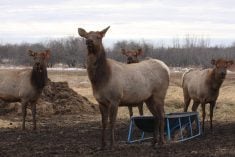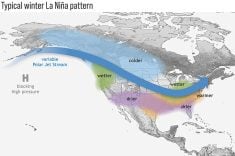The Canadian Wheat Board’s new directors were paid an average of just under $31,000 each during their first seven months in office.
A total of $432,444 in retainers and per diems was paid to 14 elected and appointed directors between Jan. 1 and July 31, 1999, according to the board’s recently released annual report for last crop year.
The director who got the biggest paycheque acknowledges that directors are well paid from the perspective of an individual grain farmer struggling to make ends meet.
But Mike Halyk, who received $41,584 during that seven-month period, makes no apologies for the remuneration paid to him or his fellow directors.
Read Also

Saskatchewan throne speech promises strong economy
Saskatchewan’s legislative agenda for the coming year will focus on meeting the challenges of new world trading relationships, said the speech from the throne.
“I think farmers are getting their money’s worth,” he said in an interview from his farm near Melville, Sask.
Busy beginning
The workload for directors, especially during those first months in office, was phenomenal, he said. Besides regular CWB business, the new directors had a number of orientation sessions and had to deal with the transportation issue.
“I ended up working almost full time in that period,” he said.
In those seven months, Halyk attended 10 board meetings, 14 committee meetings and 26 meetings with other grain industry groups. Many of those meetings lasted more than one day and almost all of them involved several days of preparatory work at home.
The lowest remuneration, $21,584, was paid to appointed director James Stanford, reflecting the fact he attended fewer meetings than any other board member.
Halyk, who was elected chair of the board’s communications committee, said he was always on the job in some way, whether that involved reading reports or discussing issues informally with farmers, other directors or industry people
“You could never allow yourself to be away from the cell phone,” he said, adding that the workload hasn’t really eased this year.
The board’s directors receive an annual retainer of $20,000, except for the chair, who receives $60,000. Committee chairs receive an additional $2,000.
Those retainers were pro-rated to reflect the seven months the directors were in office in 1998-99.
Ken Ritter, who was elected chair in April 1999, received a retainer of $15,000, reflecting one-quarter of the annual rate.
Directors also receive a per diem of $500 per full meeting day, are reimbursed for out-of-pocket expenses while working on the board’s behalf and are entitled to a maximum of $5,000 per crop year for the purposes of communicating with farmers.
Maximum set
There is an annual salary cap of $50,000 for all directors other than the chair, whose salary is capped at $90,000.
Halyk is prepared to take some heat from farmers who think the directors are paid too much.
“They’ll say we got paid $50,000 for a couple of meetings a month. But by the same token, they think nothing of phoning a director at any hour or any day of the week and saying ‘I’ve got a problem and I want some answers right now’ and you do it, because that’s your job.”














